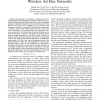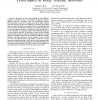ICC
2008
IEEE
14 years 6 months ago
2008
IEEE
—Wireless sensor networks are often composed of resource-constrained sensor nodes with limited memory space, computational capacity and communication range. The links in WSN are ...
ICC
2008
IEEE
14 years 6 months ago
2008
IEEE
Abstract—In this paper, we introduce a framework for distributed opportunistic scheduling in multihop wireless ad hoc networks. With the proposed framework, one can take a schedu...
ICC
2008
IEEE
14 years 6 months ago
2008
IEEE
— In high density (HD) WLANs, packet losses can occur due to hidden terminals (asynchronous interference) or collisions (synchronous interference). Without differentiating above ...
ICC
2008
IEEE
14 years 6 months ago
2008
IEEE
ICC
2008
IEEE
14 years 6 months ago
2008
IEEE
Abstract—Secure multicast has become an important component of many applications in wireless networks. In this paper, we investigate secure intra and inter group information shar...
ICC
2008
IEEE
14 years 6 months ago
2008
IEEE
— This paper investigates minimizing mutual interferences in wireless ad hoc networks by means of topology control. Prior work defines interference as a relationship between link...
ICC
2008
IEEE
14 years 6 months ago
2008
IEEE
— Wireless mesh networks (WMNs) have recently emerged to be a cost-effective solution to support large-scale wireless Internet access. One important component of realizing large-...
ICC
2008
IEEE
14 years 6 months ago
2008
IEEE
— Motivated by the recent findings of super-diffusive patterns in mobility traces, we investigate the impact of superdiffusive behavior of mobile nodes on contact-based metrics ...
ICC
2008
IEEE
14 years 6 months ago
2008
IEEE
—With the rapid expansion of satellite communication, an increasing number of unattended ground terminals are spreading out to serve local customers. And there is a great demand ...
ICC
2008
IEEE
14 years 6 months ago
2008
IEEE
— TCP-friendly rate control (TFRC) is a congestion control technique that trade-offs responsiveness to the network conditions for a smoother throughput variation. We take advanta...





